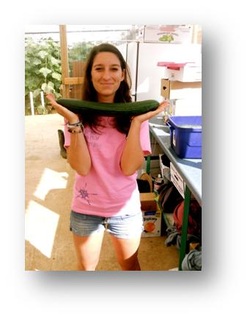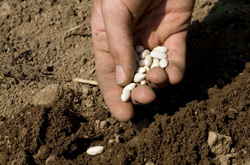How Seed Saving Can Save Us All

I come from a farm in Hawaii. A cucumber farm. Where I’ve spent many long hours and days picking, tending, washing, weighing, and packaging in our hot greenhouses. Seeded by my hands in the dirt and the sun on my back two things resulted from this upbringing. 1) I can hold a cucumber in my hand and tell you to the tenth of a pound how much it weighs. 2) I grew an affinity towards farmers, food, and agricultural justice.
In reading Nicole’s article last week about how “Saving Seeds Can Save Your Life,” we explored evidence of the adverse effects GM foods on our health. We also discovered the wild world of agribusiness corruption and monopoly that link directly from these GM businesses. So next, we naturally raise the questions: Why do farmers farm these crops? If they don’t want to be caught up in the corporate seed system by Monsanto or other industry giants, forced to repurchase infertile seeds and pesticides each harvest and sell their yields at bottom of the barrel prices, why don’t they just buy seeds elsewhere? Unfortunately, it’s not quite that simple.
Why Do Farmers Farm Monsanto?
First, a little history on a big company: Monsanto is the largest seed company in the world. It controls 95 percent of the market for insect and herbicide resistant cotton traits. In 2008, Monsanto had shares of up to 65 percent for GM corn and soybeans and about 45 percent for GM corn. During the late 1990s and through the 2000s, Monsanto acquired almost 40 companies “creating the horizontal and vertical integration that underlies the firm’s platforms in cotton, corn, and soybeans,” according to a whitepaper by American Antitrust Institute’s vice president and senior fellow, Diana Moss. Most of the acquisitions were seed companies.
American farmers’ hands are tied. Not so long ago, traditional methods of seed saving were the norm. At each harvest, a small portion of a farmer’s crop would be put aside for the seeds to be saved, cleaned, dried, and stored to plant for the next season. Seed, as a renewable resource, was simply farming’s and nature’s way of sustaining itself. However, today genetically modified crops are so widely grown that the farms that choose to maintain natural growing processes are in great danger of the GM crops of their neighbors cross-pollinating with their own. Once this happens, the farm is at risk of losing everything. This is not because their yield is now tainted, but because Monsanto could (and will) sue them for infringement on the company’s patents of bioengineered seed. Now contaminated, the farm is then left with no other option than to purchase Monsanto seed, in fear that the company will simply come back the following year and sue them again.
This is not the only scenario in which our farmers are stuck between a rock and a hard place. Monsanto is also pushing anti-democracy laws that strip communities of their power to stop GMO crops from being planted in their own counties. Without this control, one GM farm could disrupt the crops of many other farms in the area. Monsanto has also made it illegal to own seed cleaning (and therefore seed saving) equipment without having it registered, an endeavor that can cost from $1-1.5 million for each machine for each type of seed. These restrictions, threats, and unaffordable endeavors are forcing our nation’s farmers, against their will, to become a part of the very system that is devastating them.
But the scope broadens. The Monsanto monopoly not only plagues America; its reach extends far beyond our borders engulfing the entire globe in its enterprise.
A Global Terror
In 1998, the corporate machine changed India’s farming industry overnight. With new structural policies put in place by the World Bank, the country was forced to open its seed sector to global industry giants such as Monsanto and switch from farm saved seeds to fertile corporate seeds. This transition required irrigation and fertilization of the seeds which also needed to be repurchased every year due to patents on their non-renewable traits. This transformation of seed from a renewable resource to a non-renewable input had far-reaching and tragically devastating implications for the nation.
As farmers were forced to re-buy their seeds each year, instead of saving their own for no cost, the indebtedness of peasant farmers rose quickly and dramatically. This changed the once positive economy to a negative, debt-ridden one. This change was due to two factors: the falling price of farm commodities and the rising price of production, both the product of corporate globalization and trade.
Pre-Monsanto, cotton seed cost Rs 7/kg. It was rain fed, could be inter-cropped with other produce, and was naturally pest resistant. GM Bt-cotton seed cost Rs 17,000/kg, could only be grown as a mono-culture required irrigation, and actually created new pests. Because of this, farmers were forced to purchase and use 13 times the pesticides they were previously using. The switch from biodiversity to mono-cropping also greatly increased the risk of crop failure, as bulk corporate seed is not adaptable to the diverse local environment. Monsanto sold their seeds under falsifications that they would produce yields of 1500/kg/year. In reality, farmers’ harvests were only 300 to 400/kg/year. Oftentimes even entire crops would fail, leaving peasant farmers in literally dire situations. This equation of high cost for farmers and unreliable production create an inescapable debt trap and a suicide economy.
Since 1997, over 200,000 Indian farmers have committed suicide. The region in India with the highest suicide rate experiences as many as 4,000 per year, that’s 10 suicides per day. Maybe not so coincidentally, this region also has the highest acreage of Monsanto (GM) Bt-cotton. In acts of protest and hopeless desperation, the main method of Indian farmers taking their own lives is to drink Monsanto pesticides – their only way to escape the incredible debt they have been left in by the company.
And, as the regime of Monsanto doesn't end with the USA so it doesn't end with India. In the US, a $4 billion subsidy is granted to their own GM cotton growers annually. This artificially drives down US cotton prices, creating a barrier unattainable for poor African countries to penetrate. Countries such as Burkina Faso, Benin, and Mali, who previously were competitive in this global market, are now losing $250 million every year, perpetuating the same type of suicide economy as India. In 2007, 1,593 farmers in these regions took their own lives- a number that before 2000 was reportedly zero.
But it’s not only the farmers being robbed. This economy is suicidal on three levels:
1) To the farmer whose family is now left without a caretaker, whose land is infertile, and whose life is destroyed;
2) To the people in their community who have lost, with the farmer, their food source and will fall even deeper into poverty and hunger; and
3) To the human species as we devastate the natural worth of seed, biodiversity, soil and water upon which we depend on for our own biological survival.
The inability to fund commodity production year to year in addition to the unreliability of the mono-culture crops has created unbearable debt for already impoverished farmers. These debts, un-payable from farm revenues, have driven farmers to take the most extreme of measures. According to leading global seed rights advocate Vandana Shiva, the bottom line is simple. “Seed saving gives farmers life. Seed monopolies rob farmers of life.”
Seeds of Change
Although suicide economies worldwide are drastic and horrific, they are not inevitability. Although the majority of US farmers have become cogs in the machine of a dictator, there are a few things that can begin to turn the wheels the opposite way. Seed saving can be the answer to so many interlinking global problems we are facing today. Here are some actions that can be taken.
On a global level:
• A shift back to natural seed varieties that farmers can save and share [as opposed to non-renewable GMO seeds]
• A shift to organic farming [from chemical farming]
• A shift to fair trade and just-commodity prices worldwide [as opposed to unfair trade based on false prices from government subsidies. (Cotton farmers who have made these changes can earn up to 10 times the revenues of farmers still growing Monsanto cotton.)
On a community level:
• Push for labeling of GMO products in your local legislature. Vote.
• Create community seed banks and promote saving and sharing seeds among farms and gardens.
• Support legal action to challenge seed patents and bio-piracy.
On an individual level:
• Be conscious of the products you purchase. Support organic and fair trade produce.
• Save your own seeds! Grow what you can. Plant a garden with heirloom seeds and become self-sustaining in any ways you can.
• Support the Seed Freedom Movement and Farmers’ Rights by signing the Declaration on Seed Freedom and learning more at: seedfreedom.in
Seed saving can be a very simple solution to an enormously complex problem. Plant native seeds in the ground, help them grow, and return to the natural cycle of the earth. But simple doesn't necessarily mean easy. Ahead the obstacles and doubt gravel a long, uphill road. However, if each of us is aware, hopeful, and prepared to take the first steps toward a sustainable future, we will undoubtedly effect global change. In fact, “A small group of thoughtful people can change the world. Indeed, it’s the only thing that ever has.” (Margaret Mead)
Join us next week to meet Kristina and her take on “How Saving Seeds Can Save the Environment!”
Shiva, Vandana. "From Seeds of Suicide to Seeds of Hope: Why Are Indian Farmers Committing Suicide and How Can We Stop This Tragedy?" The Huffington Post. TheHuffingtonPost.com, 28 Apr. 2009. Web. 11 Nov. 2012.
"Surviving the Middle Class Crash." Surviving the Middle Class Crash. N.p., n.d. Web. 14 Nov. 2012.
"The Monopoly Named Monsanto." Triple Pundit RSS. N.p., n.d. Web. 14 Nov. 2012.

 RSS Feed
RSS Feed
